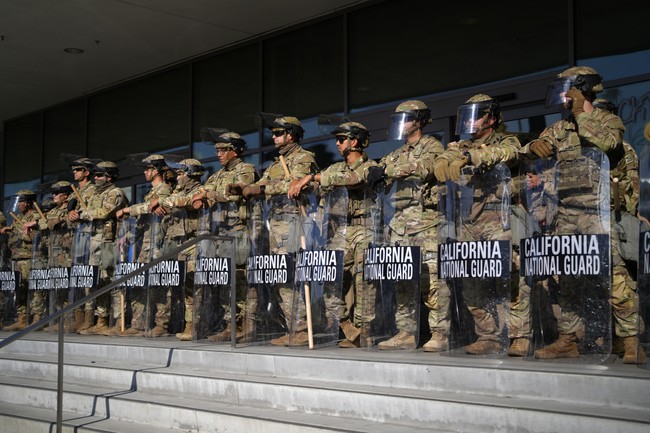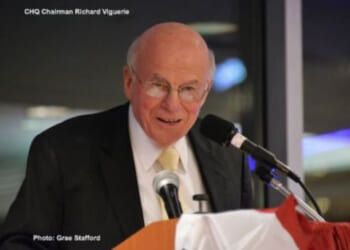
As of 10:40 am ET, the status of the National Guard deployment in Los Angeles is … exactly what it was at 10:40 am ET yesterday. That’s not to say that nothing’s changed. It changed — and then it changed back.
So what happened? Federal judge Charles Breyer had initially refused to issue a TRO when Gavin Newsom sued to force Donald Trump to relinquish control of Calfornia’s National Guard units in LA. Instead, Breyer scheduled a hearing for it that took place yesterday afternoon. At first, it sounded as though Breyer was skeptical of judicial intervention, especially as he noted that no actual injury to Calfornia’s sovereignty had taken place. Trump had not violated the Posse Comitatus Act by having Guard soldiers detain people for criminal violations.
By the end of the hearing, though, it became clear that Breyer had been convinced to act. He ordered Trump to return control of those units, but then stayed the order for 24 hours:
2/2 Full order: https://t.co/nNpyKIfbBl
— Margot Cleveland (@ProfMJCleveland) June 13, 2025
The order itself is worth reading. Breyer seems to be focusing on some interesting technicalities; for instance, Section 12406 of Title 10 should be issued through the governor’s office rather than directly to the National Guard, although that allows no real latitude for governors to block or delay the order. That could be cured almost immediately by Trump by re-issuing the declaration directly to Newsom and instructing him to inform his troops.
Breyer also remains unconvinced that federal agents in Los Angeles were unable to execute federal law in Los Angeles at the time of Trump’s order, and explicitly claims judicial authority for that review. Breyer admits that ICE was prevented from conducting some of it operations, but that was insufficient for the finding necessary in Section 12406. He then curiously adds this:
While ICE was not able to detain as many people as Defendants believe it could have, ICE was nonetheless able to execute the federal immigration laws. Indeed, ICE continues to carry out enforcement actions, executing those laws.
Bear in mind that these operations were not generalized raids on employers, but instead targeted operations involving fugitives, with judicial warrants for each. Breyer seems to admit that the rioters allowed some of those fugitives to escape, which would mean that ICE was not able to fully execute federal law in this jurisdiction. And the only reason that “ICE continues to carry out enforcement actions” in LA is because of the National Guard deployment that protects those operations and the federal building in which those operations are managed.
Anyway, that was all a little too much even for the Ninth Circuit. Remember that Breyer stayed his order for 24 hours to allow Trump to appeal the decision. It took less than sixth of that time for the Ninth Circuit to intervene — even while Gavin Newsom was taking a social media victory lap:
GAVIN NEWSOM JUST UNPINNED THIS POST following appeals court ruling in Trump’s favor— issuing a temporary HALT on lower court ruling that Trump return control of National Guard to Newsom.
Newsom is NOT having a good night… his celebration was short-lived https://t.co/Jq8u9jSr5w pic.twitter.com/6wJcBnncl6
— Libs of TikTok (@libsoftiktok) June 13, 2025
Yeah … oops. Postpone the bubbly for at least another four days, if at all:
Before: BENNETT, MILLER, and SUNG, Circuit Judges.
The court has received the government’s emergency motion for stay pending appeal. Dkt. No. 5. The request for an administrative stay is GRANTED. The district court’s June 12, 2025 temporary restraining order is temporarily stayed pending further order. See Doe #1 v. Trump, 944 F.3d 1222, 1223 (9th Cir. 2019). The response to the emergency motion is due June 15, 2025 at 9:00 AM PDT. The optional reply in support of the emergency motion is due June 16, 2025 at 9:00 AM PDT.
The panel will hold a remote hearing by Zoom on June 17, 2025 at 12:00 PM PDT.
In other words, Trump has four days more to command these troops in Los Angeles, and he will likely make the best use of them in that period. Trump could moot the suit by claiming “mission accomplished” on Monday and handing control back to Newsom, but Trump wants to make a point to other blue-state governors and mayors that the federal government does not recognize “sanctuary” status. If they refuse to cooperate with or protect federal enforcement officers in legitimate enforcement actions, Trump will federalize National Guard troops in those states, too.
Aaron Walker tried to make sense of it at our sister site Twitchy:
Of course, the X factor here is the larger court. The Ninth Circuit is easily one of the most leftist courts in the country and the entire court might try to overrule this decision. But even if that happens, we think the Supreme Court will intervene, quickly.
And it is notable that this panel intervened quickly. Cleveland posted about Breyer’s decision at 9:11 PM, eastern standard time. The Ninth Circuit panel of three judges intervened at 11:28. If we assume she posted it quickly after the decision came out, which is likely, that is a little more than two hours. That is lightning fast in judicial time. …
We think that the actual response from the these judges was something like ‘You had me at hello.’ Joking aside, we think that they were inclined to issue this stay no matter what because in essence this judge was trying to stop law enforcement as rioting continued. So we think they were waiting to be officially asked. They very much preferred to err in terms of giving Trump too much power right now, and if it turned out he wasn’t allowed to do this, to clean up the mess afterward.
There’s much to be said for this point. I made it earlier about the Insurrection Act and the impact it would have on Trump, using the Pottery Barn Rule: You broke it, you bought it. If the court forces Trump to withdraw protection around federal agents and the mobs kill one or more of them, the judiciary will utterly own that outcome. The riots are still ongoing in Los Angeles now, so the Pottery Barn Rule is even more acute. Perhaps these three jurists recognize that better than Judge Breyer did earlier in the same day. By staying this order for another five days, the appellate judges may hope that the case has been mooted in at least the acute violence sense.
And finally, despite the learned niceties in Breyer’s ruling, he’s missing the forest for the trees. The Constitution gives presidents ultimate command of all military forces, and it also gives the executive branch the authority and jurisdiction to enforce federal law in every state and locality in the US. California and Los Angeles have made it a policy to obstruct the enforcement of immigration law, which should provide more room for the use of Section 12406 to protect federal officials operating in such hostile environments to enforce the law, especially in relation to judicial warrants. Perhaps that is what the Ninth Circuit will conclude, but I am more confident that the Supreme Court will reach that conclusion in the end.
Addendum: The headline is my play on words to apply Posse Comitatus to the judiciary. Please clap.












